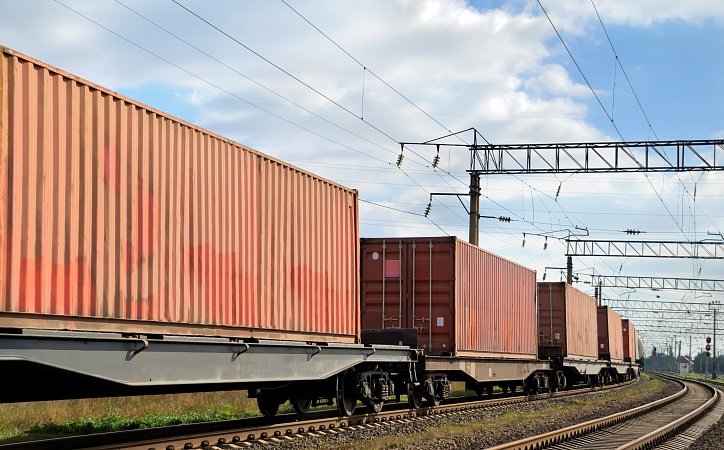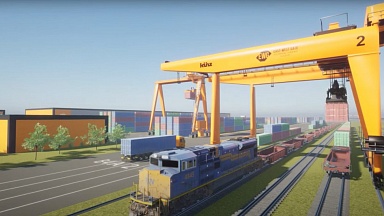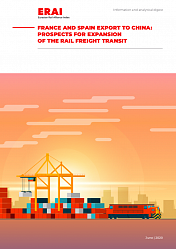The project has been approved by the Lublin Voivodeship, the region to which Malaszewicze belongs and the project was handed over to Cargotor, an infrastructure management company under PKP. According to Polish industry players, this is great news, as Malaszewicze has become one of the main bottlenecks on the transport corridor. “The current capacity is no longer sufficient to meet the growing demand”, commented Bartosz Baca, Managing Partner at BBSG, Polish Supply Management Leaders Association.
Three cities involved
The construction of the logistics center will take place in three towns, namely Zalesie, Terespol and Piszczac. It will include exisitng facilities, as well as 20 new stations. The three towns belong to thedistrict Biala Podlaska, to which also Malaszewicze belongs. Terespol is a border city, across the border from the Belarusian city of Brest, where most of the China-Europe trains transit.
The logistics center will be connected to the Polish national railway network via railway line 2 (Warszawa Zachodnia-Terespol), connecting Warsaw West Station and Trespol. In addition, the new infrastructure will be able to operate 1050-meter-long trains (the longest train that can currently operate is 750 meters), and the maximum load will be increased from 22.5 tons to 25 tons.
Three cities involved Finally, some rest
The new logistics center is an addition to the existing facilities in the area, which are unable to handle the growing volumes. “This hub will give the other 4 terminals a litte rest”, said Milosz Witkowski from IFB. “All other terminals were originally built for something other than rail containers. If this is done properly, we can finally rest after an everyday struggle with reloading in Malaszewicze. Of course this is only part of a bigger puzzle, but in my opinion the most important.”
According to Bacca, infrastructure upgrades alone are not the only solution. “Development of infrastructure can only account for a part of Małaszewicze’s success. Organisational improvements are also crucial. The potential of Małaszewicze is so substantial that we will not lose it overnight, but thoughtful and wise changes are required to make this place as operational and business friendly as possible”, he commented.
More delays coming?
Added to that is the general concern that before the upgrade can yield, a long period of construction and consequent delays lie ahead. The project will start in 2022 and is expected to take five to six years. “We must remember that the launch of the new infrastructure is scheduled for 2027/2028. And delays are natural to such big developments. Securing operational efficiency during construction and development phases are never easy and it will surely constitute an important challenge for Małaszewicze in the coming years” said Bacca.
And, notes Witkowski, it is not only in Malaszewicze where delays are taking place. “On the New Silk Road, everything is connected. There are problems in China with departures and border delays, as well as strikes in Germany and infrastructural deficiencies in Poland.”
Losing traffic
As a result of the bottleneck in Malaszewicze however, many services have been diverted to other border points and even countries. “Małaszewice is not the only Polish entry gate to the EU and other projects on the Polish border are planned”, said Bacca.
For example, transit through Russia has increased over the years. “The volume of Asian goods handled in the Kaliningrad region has almost tripled over the past two years. The newly opened terminal in Chernyakhovsk, with a capacity of 450,000 TEUs or the development of the Skandawa/ Zheleznodorozhny border crossing only prove that Russia’s ambitions do not stop there. Some important developments are also noted on the southern corridor. However, Malaszewicze remains Poland’s strongest card in this game.”
Witkowski agrees. ‘At least 90 per cent of all volumes from China to Europe are coming this way. However, the market is always searching for alternatives. We should also remember that during construction other border crossings or terminals like Sławków/Braniewo/Zamość will benefit as well, and maybe that is the right push for the industry.”
The project has been approved by the Lublin Voivodeship, the region to which Malaszewicze belongs and the project was handed over to Cargotor, an infrastructure management company under PKP. According to Polish industry players, this is great news, as Malaszewicze has become one of the main bottlenecks on the transport corridor. “The current capacity is no longer sufficient to meet the growing demand”, commented Bartosz Baca, Managing Partner at BBSG, Polish Supply Management Leaders Association.
Three cities involved
The construction of the logistics center will take place in three towns, namely Zalesie, Terespol and Piszczac. It will include exisitng facilities, as well as 20 new stations. The three towns belong to thedistrict Biala Podlaska, to which also Malaszewicze belongs. Terespol is a border city, across the border from the Belarusian city of Brest, where most of the China-Europe trains transit.
The logistics center will be connected to the Polish national railway network via railway line 2 (Warszawa Zachodnia-Terespol), connecting Warsaw West Station and Trespol. In addition, the new infrastructure will be able to operate 1050-meter-long trains (the longest train that can currently operate is 750 meters), and the maximum load will be increased from 22.5 tons to 25 tons.
Three cities involved Finally, some rest
The new logistics center is an addition to the existing facilities in the area, which are unable to handle the growing volumes. “This hub will give the other 4 terminals a litte rest”, said Milosz Witkowski from IFB. “All other terminals were originally built for something other than rail containers. If this is done properly, we can finally rest after an everyday struggle with reloading in Malaszewicze. Of course this is only part of a bigger puzzle, but in my opinion the most important.”
According to Bacca, infrastructure upgrades alone are not the only solution. “Development of infrastructure can only account for a part of Małaszewicze’s success. Organisational improvements are also crucial. The potential of Małaszewicze is so substantial that we will not lose it overnight, but thoughtful and wise changes are required to make this place as operational and business friendly as possible”, he commented.
More delays coming?
Added to that is the general concern that before the upgrade can yield, a long period of construction and consequent delays lie ahead. The project will start in 2022 and is expected to take five to six years. “We must remember that the launch of the new infrastructure is scheduled for 2027/2028. And delays are natural to such big developments. Securing operational efficiency during construction and development phases are never easy and it will surely constitute an important challenge for Małaszewicze in the coming years” said Bacca.
And, notes Witkowski, it is not only in Malaszewicze where delays are taking place. “On the New Silk Road, everything is connected. There are problems in China with departures and border delays, as well as strikes in Germany and infrastructural deficiencies in Poland.”
Losing traffic
As a result of the bottleneck in Malaszewicze however, many services have been diverted to other border points and even countries. “Małaszewice is not the only Polish entry gate to the EU and other projects on the Polish border are planned”, said Bacca.
For example, transit through Russia has increased over the years. “The volume of Asian goods handled in the Kaliningrad region has almost tripled over the past two years. The newly opened terminal in Chernyakhovsk, with a capacity of 450,000 TEUs or the development of the Skandawa/ Zheleznodorozhny border crossing only prove that Russia’s ambitions do not stop there. Some important developments are also noted on the southern corridor. However, Malaszewicze remains Poland’s strongest card in this game.”
Witkowski agrees. ‘At least 90 per cent of all volumes from China to Europe are coming this way. However, the market is always searching for alternatives. We should also remember that during construction other border crossings or terminals like Sławków/Braniewo/Zamość will benefit as well, and maybe that is the right push for the industry.”





